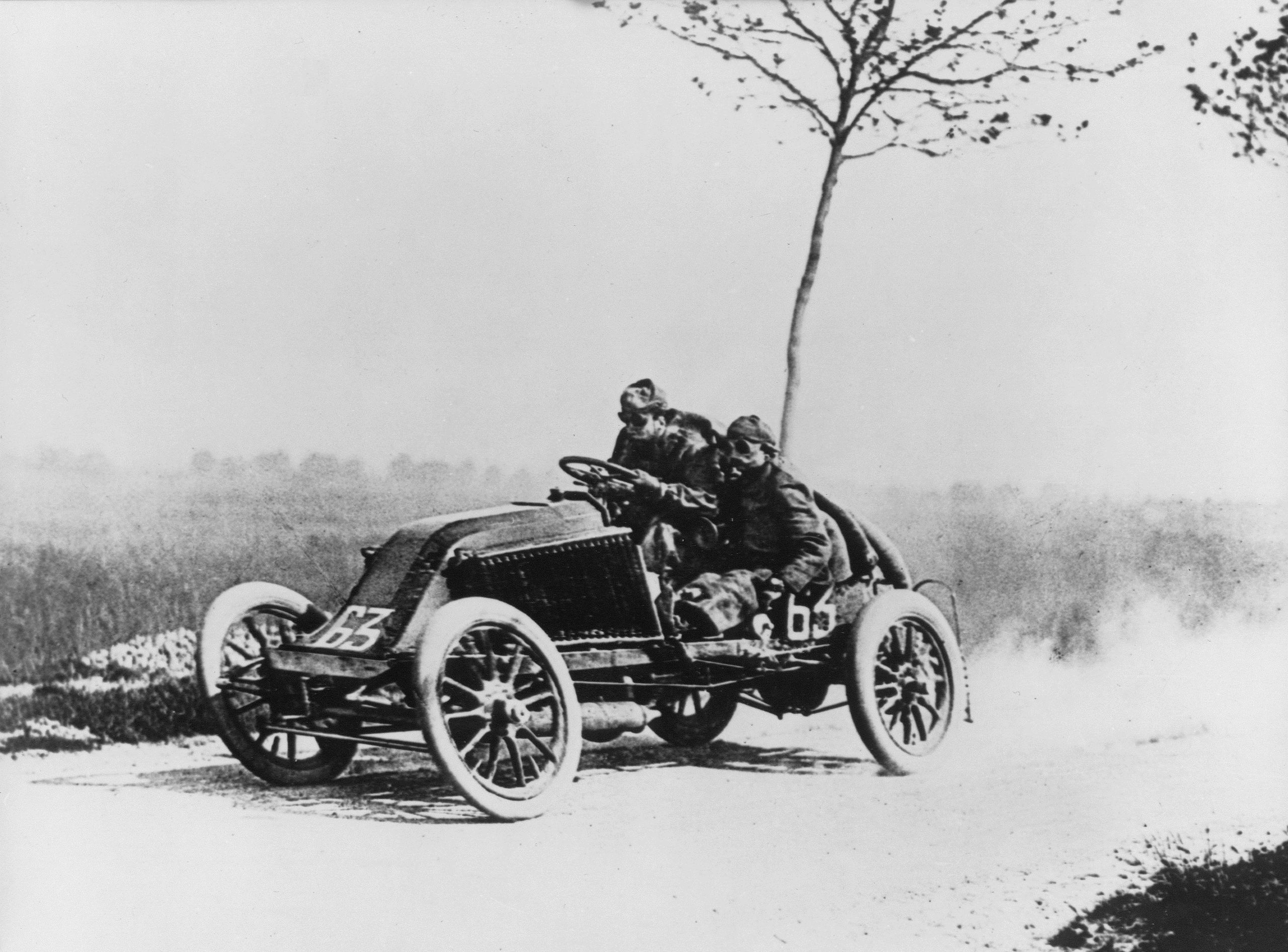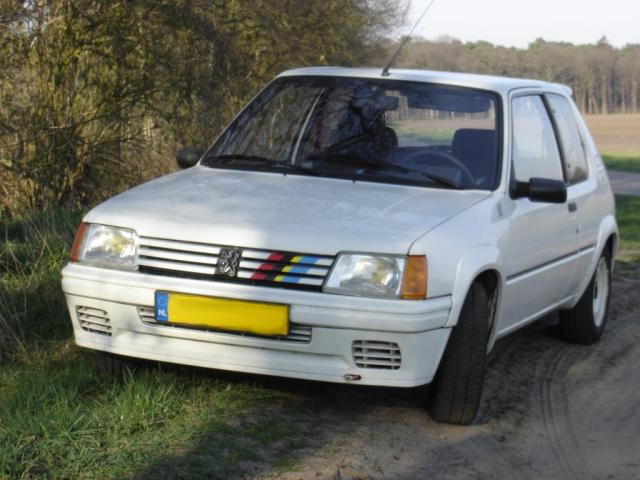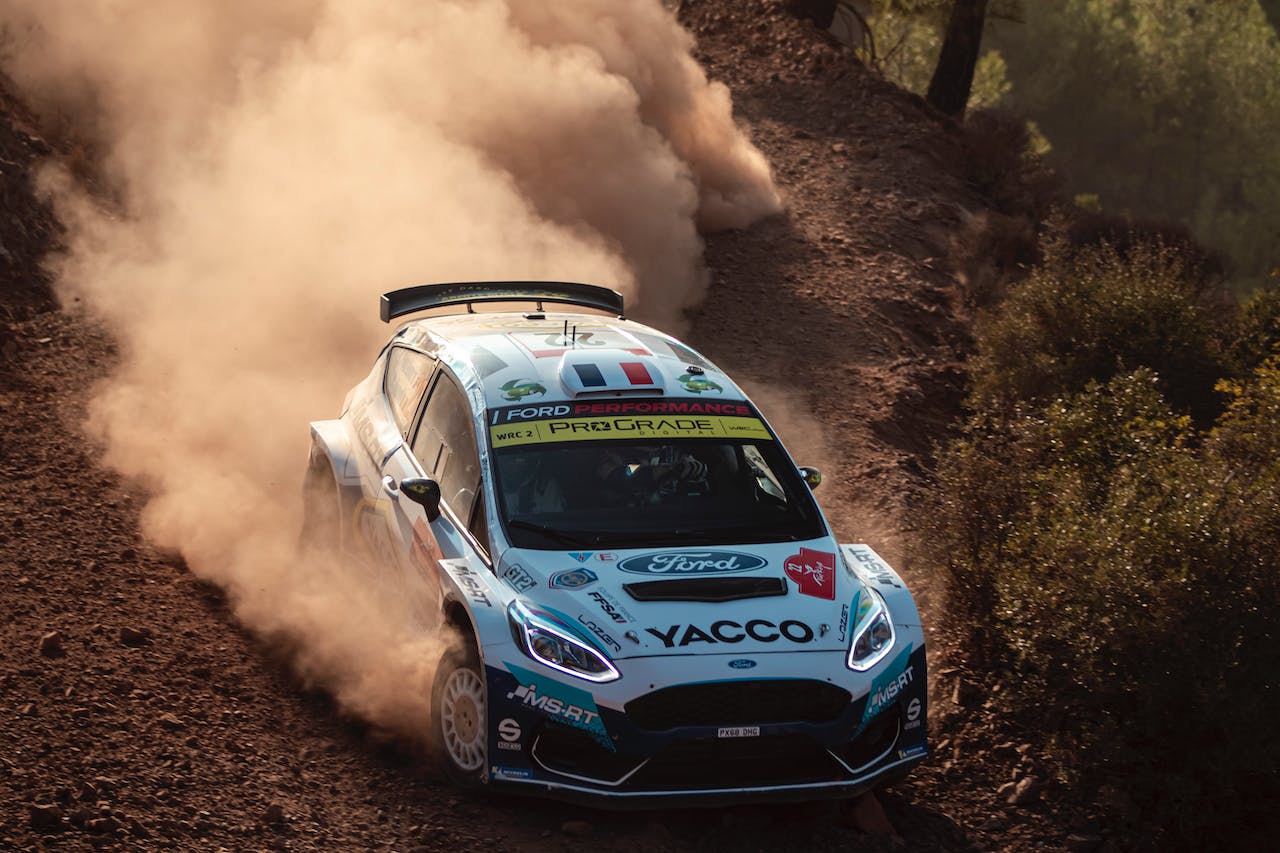Rally racing stands out in the motorsport world, offering a unique blend of high-speed racing, challenging terrains, and a test of endurance and skill unlike any other. This thrilling form of racing involves navigating off-road tracks and public roads closed to regular traffic, where drivers push the limits of their vehicles and their abilities. In this blog post, we’ll dive into the history of rallying, explore its various types, understand how rally championship points work, highlight some notable rally drivers, and discuss the specifications of a World Rally Car.
History of Rallying
Rallying, as a competitive motorsport, has a rich and varied history that traces back to the late 19th and early 20th centuries. It’s a history marked by evolution, innovation, and a relentless pursuit of speed and endurance across some of the world’s most challenging terrains. Here, we delve deeper into the origins and development of rallying, highlighting key moments that have shaped the sport into what it is today.
The Early Days

The genesis of rallying can be linked to the 1894 Paris-Rouen Horseless Carriage Competition, considered by many as the world’s first motor race. However, it was the 1911 Monte Carlo Rally that truly encapsulated the spirit of modern rallying. This event was designed not just to test speed but also the endurance and reliability of vehicles over long distances, navigating through treacherous winter conditions to reach the glamorous destination of Monte Carlo.
Post-War Era and the Rise of the European Rally Championship
Following World War II, rallying experienced a significant boom in Europe. The 1950s saw the introduction of the European Rally Championship, bringing a semblance of organization and recognition to the sport. Events like the Rallye Automobile Monte Carlo and the RAC Rally in the UK became fixtures on the international motorsport calendar, drawing competitors from across the continent.
The Birth of the World Rally Championship
The sport’s growing popularity led to the creation of the World Rally Championship (WRC) in 1973, marking a new era in rallying. The WRC brought together the most challenging and prestigious rallies in the world under a single championship banner. This period also saw the emergence of iconic rally cars, such as the Lancia Stratos – the first car designed from the ground up for rallying, which went on to win the WRC three times consecutively from 1974 to 1976.
Group B: The Golden Era

The 1980s are often remembered as the golden era of rallying, dominated by the infamous Group B category. Introduced in 1982, Group B regulations allowed for minimal restrictions on design and technology, leading to the creation of some of the fastest, most powerful, and ultimately, most dangerous rally cars ever built. Icons like the Audi Quattro, Peugeot 205 T16, and Lancia Delta S4 became legends of the sport. However, following a series of tragic accidents, Group B was disbanded in 1986 in favor of safer regulations.
The Modern Era
The post-Group B era saw the introduction of Group A and later World Rally Car specifications, focusing on improving safety while maintaining the competitive edge that makes rallying so exciting. The 1990s and 2000s were marked by intense rivalries among manufacturers such as Subaru, Mitsubishi, Ford, and Peugeot, and between legendary drivers like Tommi Mäkinen, Colin McRae, Carlos Sainz, and Sébastien Loeb.
Rallying Today
Today, the WRC continues to thrive, with advancements in technology and safety making the sport more competitive and thrilling than ever. Hybrid technology has been introduced, aiming to make the sport more sustainable while maintaining the high-performance standards that fans expect. The championship now spans across continents, showcasing a diverse range of terrains, from the snowy forests of Sweden to the rugged mountains of Argentina, continuing the tradition of rallying as a supreme test of man and machine against the elements.
Types of Rally
Rallying is a multifaceted motorsport, encompassing various formats that test the skill, endurance, and adaptability of both driver and machine. Each type of rally offers a unique set of challenges, environments, and rules, catering to a wide range of motorsport enthusiasts. Here, we delve deeper into the different types of rallies, exploring the distinctive features that define each.
Stage Rallies
Stage rallies, or traditional rallies, are the most common and widely recognized form of rallying. This format consists of a series of timed sections known as “special stages,” which are closed to public traffic. Drivers compete one at a time, racing against the clock, with the goal of achieving the lowest cumulative time across all stages. The stages can vary dramatically in surface type, from gravel and dirt to asphalt and snow, requiring drivers to exhibit exceptional versatility. The World Rally Championship (WRC) is the pinnacle of stage rallying, featuring events in diverse locations worldwide.
Rallycross
Rallycross is a more spectator-friendly version of rallying that combines elements of rallying and circuit racing. Competitions take place on a closed circuit, typically featuring both paved and unpaved sections. The races are short and intense, involving multiple drivers competing head-to-head in heats, leading to a final showdown. Rallycross events are characterized by their high-energy, bumper-to-bumper racing action, making them a hit with fans who enjoy the thrill of close competition.
Historic Rallying
Historic rallying is dedicated to preserving and celebrating the history of rally racing. This type of rallying is for vintage and classic rally cars that have significant historical value. Historic rallies often replicate the conditions and routes of past events, offering a nostalgic experience for participants and spectators alike. These events focus less on outright speed and more on accuracy, reliability, and the preservation of the classic rally experience.
Marathon Rally
Marathon rallies, also known as endurance rallies, are long-distance events that can span thousands of kilometers and several days or even weeks. These rallies are known for their grueling nature, testing not just the speed but the durability and reliability of vehicles over extreme distances and often through harsh conditions. The Dakar Rally, one of the most famous marathon rallies, challenges participants with a variety of terrains, including deserts, mountains, and savannahs, across multiple countries.
Cross-Country Rally
Cross-country rallies are similar to marathon rallies but often place a greater emphasis on navigation and off-road driving skills. These events cover vast distances and incorporate varied terrains, requiring teams to navigate using GPS and roadbooks. The focus is on endurance and the ability to tackle natural obstacles, from sand dunes to rocky paths, making cross-country rallying a true test of off-road prowess.
Navigation Rallies
Navigation rallies, or regularity rallies, prioritize precision driving and navigation over speed. Competitors are given a set route and must adhere to specific average speeds across various segments. The challenge lies in maintaining these prescribed speeds and accurately following the route, with penalties for arriving too early or too late at checkpoints. Navigation rallies often use classic or vintage cars, combining the skills of precise driving and accurate navigation.
Sprints and Hill Climbs
While not rallies in the traditional sense, sprints and hill climbs are closely related to rallying. These events involve timed runs up a hill or a short stretch of road, with drivers competing individually to set the fastest time. The focus is on driver skill and vehicle performance over a relatively short distance, offering a pure test of acceleration, handling, and braking.
Rally Championship Points
The allocation of championship points in rallying is a critical aspect that determines the success of drivers and teams throughout a season. Understanding how these points are awarded, and the strategic implications they hold, is essential for competitors and fans alike. This section will delve into the intricacies of rally championship points, including their structure, importance, and impact on the championship standings.
Structure of Championship Points
The World Rally Championship (WRC), as well as many national and regional championships, follow a specific structure for awarding points to competitors based on their finishing position in each event. While the exact distribution can vary slightly between different series and over time, the principle remains to reward the most successful participants with a descending scale of points.
For example, in the WRC, points are awarded to the top ten finishers in each rally as follows:
- First place – 25 points
- Second place – 18 points
- Third place – 15 points
- Fourth place – 12 points
- Fifth place – 10 points
- Sixth place – 8 points
- Seventh place – 6 points
- Eighth place – 4 points
- Ninth place – 2 points
- Tenth place – 1 point
Additionally, the WRC includes a Power Stage in each rally, providing an opportunity for drivers to earn extra points. The fastest five drivers in this stage are awarded points from 5 for the fastest down to 1 for the fifth fastest.
Importance of Championship Points
Championship points serve several key purposes within the sport of rallying:
- Determining Champions: The accumulation of points throughout the season determines the drivers’ and manufacturers’ champions, making every point crucial for the overall success.
- Strategic Decision Making: Teams and drivers often make strategic decisions based on points standings, such as taking calculated risks to gain extra points or adopting a conservative approach to protect their position in the championship.
- Consistency Over Wins: While winning rallies is the ultimate goal, consistently finishing in a points-scoring position can be equally important for championship contention, highlighting the importance of reliability and strategy.
Impact on Championship Standings
The points system encourages consistent performance across the entire season. A single rally win is significant, but a driver who consistently finishes in the top positions without necessarily winning can still contend for or even win the championship. This system ensures that the championship remains competitive and open, often until the final events of the season.
For teams, the points not only reflect their success in the drivers’ championship but also play a crucial role in the manufacturers’ championship. Here, the combined efforts of a team’s drivers contribute to the overall standing, emphasizing the importance of having a strong, consistent lineup.
Notable Championship Battles
The history of rallying is filled with seasons where championship points have led to intense battles that came down to the wire. For example, the 2003 WRC season saw Petter Solberg win the drivers’ championship by a single point over Sébastien Loeb, illustrating how every point earned throughout the season can be decisive. Similarly, the manufacturers’ championship often sees fierce competition, with strategic decisions in the final rallies making the difference between winning and losing.
Rally Drivers
Rally drivers are a unique breed of motorsport athletes, embodying a mix of bravery, skill, and adaptability unmatched in many other sports. These individuals navigate treacherous terrains at breakneck speeds, relying on their keen senses, quick decision-making, and intimate knowledge of their vehicles. In this expanded overview, we delve deeper into the world of rally drivers, exploring their characteristics, preparation, and the legends who have left indelible marks on the sport.
Characteristics of Rally Drivers
- Adaptability: Rally drivers excel in adapting to rapidly changing conditions. Whether it’s shifting weather patterns, varying road surfaces, or mechanical issues, they must adjust their driving style instantly to maintain speed and control.
- Endurance and Focus: Rallying can be physically and mentally exhausting, with events spanning several days and covering vast distances. Drivers must maintain intense concentration for extended periods, all while managing fatigue.
- Teamwork and Communication: While the driver gets most of the spotlight, rallying is very much a team effort. A seamless partnership with the co-driver, who provides pace notes and navigational instructions, is crucial for success. Effective communication and trust between the driver and co-driver can make or break a rally.
- Technical Knowledge: A deep understanding of their car’s mechanics and the ability to diagnose and sometimes address issues on the fly can be invaluable, especially in long-distance or remote rallies where immediate support from a service crew may not be available.
Preparation and Training
Preparing for a rally involves rigorous physical training, mental conditioning, and countless hours of practice. Drivers often spend time on simulators and closed courses to hone their skills, including braking, cornering, and car control on various surfaces. Physical fitness is crucial for withstanding the g-forces, vibrations, and impacts encountered during a rally. Additionally, studying onboard videos and conducting reconnaissance runs, where allowed, helps drivers and co-drivers familiarize themselves with the stages ahead of the competition.
Legends of Rallying
The history of rally driving is adorned with individuals whose talents and achievements have become the stuff of legend.
- Sébastien Loeb: Often considered the greatest rally driver of all time, the Frenchman has won the World Rally Championship (WRC) a record nine times. Loeb is renowned for his precision driving and versatility, having successfully competed in various motorsport disciplines.
- Colin McRae: The Scottish driver’s fearless driving style and determination made him one of the most popular rally drivers in the world. McRae became the youngest WRC champion in 1995 and remained a competitive force in the sport until his untimely death in 2007.
- Tommi Mäkinen: The Finnish driver is one of the sport’s most successful competitors, with four consecutive WRC titles in the late 1990s. Mäkinen is known for his relentless work ethic and exceptional car control on snow and ice.
- Michèle Mouton: A trailblazer for women in motorsport, the French driver came tantalizingly close to winning the WRC title in 1982, finishing as runner-up. Mouton’s success in a male-dominated sport, including victories in some of the most challenging rallies, has inspired generations of female racers.
The Modern Era
Today’s rally drivers continue to push the boundaries of what’s possible on four wheels. Current stars like Sébastien Ogier, Ott Tänak, and Elfyn Evans carry on the legacy of their predecessors, showcasing incredible skill and determination. With advances in safety and technology, drivers can now reach new levels of performance, but the essence of rallying remains the same – a deep connection between driver, car, and the road that provides an unparalleled motorsport experience.
World Rally Car
Introduced in 1997, the World Rally Car specification marked a significant shift in the approach to rally car design and performance. This came as a response to the need for more relevant, safer, and cost-effective rally cars that would still provide the excitement and competition that fans had come to expect. Over the years, the regulations have evolved to improve safety, reduce costs, and make the sport more environmentally sustainable, leading to the introduction of hybrid technology in the latest generation of World Rally Cars.
Characteristics of a World Rally Car
- Base Vehicle Requirements: World Rally Cars are based on production models, but with extensive modifications. The base model must be a production car, with a minimum number produced for the public.
- Engine and Power: Under the hood, WRC cars are equipped with 1.6-liter turbocharged engines, featuring direct injection and capable of producing over 380 horsepower. The introduction of hybrid technology has added an electric motor, providing additional power and making the cars more environmentally friendly.
- Drivetrain and Suspension: All World Rally Cars use a four-wheel-drive system, allowing them to maintain traction on the diverse and often slippery surfaces encountered in rallying. The cars also feature sophisticated suspension systems designed to absorb the impacts of jumps and rough terrain, ensuring durability and control.
- Safety Innovations: Safety is paramount in the WRC. Cars are equipped with a roll cage, energy-absorbing structures, and HANS devices to protect the driver and co-driver. Advances in materials and design have continually improved the safety of these vehicles over the years.
- Aerodynamics: Aerodynamic features, including spoilers, diffusers, and aerodynamic body kits, are carefully designed to provide downforce, improving grip and stability at high speeds.
Impact of the World Rally Car
The introduction of the World Rally Car has had a profound impact on the sport of rallying:
- Performance and Competition: The performance capabilities of World Rally Cars have elevated the competition, leading to faster stage times and more closely contested championships.
- Technological Advancement: The continuous development of World Rally Cars has driven technological advancements that often trickle down to production vehicles, including improvements in safety, efficiency, and performance.
- Sustainability: The latest regulations, including the move towards hybrid technology, reflect the sport’s commitment to sustainability and environmental responsibility, setting a precedent for motorsports worldwide.
Iconic World Rally Cars
Several World Rally Cars have left an indelible mark on the sport, becoming icons in their own right. Cars like the Subaru Impreza WRC, Mitsubishi Lancer Evolution, and Ford Focus RS WRC have not only achieved great success on the rally stages but have also won legions of fans with their performance, design, and contribution to the rallying legacy.
Conclusion
The history of rallying is a testament to human ingenuity, passion, and the relentless pursuit of pushing the boundaries of automotive performance. From its humble beginnings to the high-tech spectacle it is today, rallying has maintained its core appeal – the challenge of navigating diverse terrains at breakneck speeds, where every second counts. It’s a sport that has evolved with the times but remains true to its adventurous spirit, captivating fans around the world with its unique blend of racing, endurance, and spectacle.
Rally racing offers an exhilarating mix of speed, skill, and endurance, set against the backdrop of some of the world’s most challenging and diverse terrains. From its historic beginnings to the modern-day spectacle of the WRC, rallying has captivated fans and tested drivers and their machines to the limit. Whether it’s the battle against the clock in a stage rally, the intense competition of rallycross, the nostalgia of historic rallying, or the endurance of marathon events, rally racing has something for every motorsport enthusiast. As the sport continues to evolve, one thing remains constant: the sheer thrill of the race.



